Ukrainian pilots probably won’t fly American-made F-16 Fighting Falcon fighter jets until 2024 at the earliest.
According to the director of the U.S. Air National Guard, Ukrainian pilots are expected to arrive at Morris Air National Guard Base in Tucson, Arizona this fall and could be fully trained to operate these fourth-generation airframes by the end of the year.
Depending on the pilots’ English proficiency and previous fighter jet experience, it could take as little as three months for proper training. However, flying the F-16s is not the only thing Ukrainians will need to learn.
Maintenance is key to the fighters’ longevity, especially since the F-16s are expected to immediately fly in combat missions once they reach Ukraine After these pilots complete their stint in the U.S., they will head to Europe to complete additional training through NATO allies.
F-16s for Ukraine: The Backstory
When Russia first invaded Ukraine, Kyiv officials immediately pleaded with the U.S. and its NATO allies to provide more advanced fourth-generation platforms as part of their aid packages. While the West has supplied Ukraine with billions of dollars’ worth of weaponry, funds, and heavy equipment over the last year and a half of warfare, the White House initially was adamant that sophisticated fighter jets would never be thrown into the mix.
Last spring, senior civilian and military leaders at the Pentagon asserted that delivering airframes like the Fighting Falcon was “not an immediate priority” for the Department of Defense.
This changed, however, during the G-7 summit in Hiroshima, Japan this May, when U.S. President Joe Biden announced Washington would join the F-16 coalition.
This stark turnaround was not the first time the White House reversed policies regarding its Ukraine contributions, although it may turn out to be the most significant.
A Brief Overview of the Fighting Falcon
The F-16 was developed for the U.S. Air Force in the 1970s, incorporating knowledge gained from the military’s aerial experiences in the Vietnam War and Korean War. The legendary platform has been a mainstay of the service for nearly five decades. Over time, the F-16 has undergone a series of facelifts in order to maintain its edge over competitors.
Today, these fighters are equipped with advanced technology including an Active Electronically Scanned Array radar capable of tracking up to 20 targets at the same time.

An F-16 Fighting Falcon pilot assigned to the 134th Expeditionary Fighter Squadron performs preflight checks at the 407th Air Expeditionary Group, Dec. 29, 2016. The 134th EFS is flying combat missions for Operation Inherent Resolve to support and enable Iraqi Security Forces’ efforts with the unique capabilities provided by the fighter squadron. (U.S. Air Force photo/Master Sgt. Benjamin Wilson/Released)
While the platform certainly has robust capabilities, some analysts are not convinced its presence in Ukraine will have a significant impact. Perhaps the most notable criticism comes from military experts who worry these jets could become sitting ducks for Russia’s advanced missile arsenal.
The Fighting Falcon has never actually gone up against Moscow’s air defenses in combat before. Additionally, the high-tech iterations of the F-16 that feature new technology will not be the fighters provided to Kyiv.
The jets that the Dutch will provide were actually deemed obsolete by the country and would be headed to the graveyard had they not been earmarked to support Kyiv’s defense.
Maya Carlin, a Senior Editor for 19FortyFive, is an analyst with the Center for Security Policy and a former Anna Sobol Levy Fellow at IDC Herzliya in Israel. She has by-lines in many publications, including The National Interest, Jerusalem Post, and Times of Israel. You can follow her on Twitter: @MayaCarlin.

